Bob Hill
-
- Workboat Design: Interview with Bob Hill Marine News, Jun 2018 #14
Robert (Bob) Hill of Ocean Tug & Barge Engineering Corp., of Milford, MA has specialized in the design of AT/B’s for many years. Hill’s name is, in most maritime circles – here and across the big pond – synonymous with the words “articulated tug/barge systems.”
As probably the world's most experienced designer of large articulated tug/barge (AT/B) systems, Hill’s success comes, in part, from a willingness to innovate. Ocean Tug & Barge Engineering Corporation and Robert Hill are the co-inventors of the Intercon Connection System. In a nutshell, his firm has had a hand in over 70% of the operational AT/B’s in service in America – including, 80% of those built or converted since 1994. In large part due to Bob Hill’s efforts, the AT/B is now a familiar standard in the U.S. flag fleet for coastal, Jones Act and some inland applications. This month, Hill gives us an update on what’s new in the world of AT/B’s, why, and what’s looming just over the horizon.
A flurry of replacement tonnage has occurred in the last five years, but the need for coastwise tonnage, especially in the tanker sector, is slowing. Are other opportunities in other sectors making up for that?
The short answer is YES. A longer, more detailed narrative would run afoul, in my case, of the myriad “Confidentiality Agreements” that we must sign onto with clients. That said; we work with unusual AT/B's; tackling the new projects that surface. We have done everything from the Mosaic/Savage Ammonia Carrier AT/B, to the Great Lakes Dredge and Dock AT/B hopper dredge, to the SeaOne Maritime CGL AT/B's and Minyan Marine's “Chemitainer” design. We are currently servicing projects that run the gamut from LNG carriers, to large bulk carriers, to container carriers, to bunkering barges to railcar carriers. If a ship can do it - an AT/B can do it. It is that simple. We are also seeing inquiries for smaller AT/B's - tugs under 3000 HP and barges under 250 feet.
Some aspects of U.S. yards are doing well – ferries, for example. How active is the ATB buyer market? Has it changed much? What are they asking for? Rank these in order of preference for today’s domestic operators.
We are seeing a wider range of clients than perhaps 10 years ago. We continue to design for traditional clients such as tug and barge companies, but increasingly we are being contacted by traditional shipowners, commodity brokers, and industrial clients. Our workload potential has expanded so much that it at times eclipses our staff size and to that end, a major announcement about our firm is coming in the next month.
(1.) Different Service (as compared to oil and product carriers);
(2.) Different Size Units (both larger and especially smaller);
(3.) Higher Speeds (and less fuel consumed vs. traditional); and
(4.) Propulsion Changes (to make number 3 possible).
Where is the biggest opportunity for future ATB growth? Why?
We feel that the introduction of the AT/B into services and/or geographical areas that it had previously not been employed is future of the concept. If it can move by water, an AT/B can move it. This includes the use of AT/B's that can transit both deep and shallow water, large AT/B's (we have a design for a liquid carrier of 100,000 DWT), LNG, and CNG gas carrier AT/B's, and vehicle carriers. The list is almost endless.
Q-LNG is building an ATB LNG bunker vessel. What else exciting or cutting edge is being planned or underway at the moment?
A long time ago, we designed a 10,000 cubic meter AT/B LNG carrier for Argent Marine. We remain in contact with Argent regarding future work, so LNG is basically on the horizon in general. However the expected rush to LNG never materialized fully, and most LNG projects we deal with are on hold. Other projects to move gasses in other places by various means are alive and well. For example, the Mosaic/Savage Ammonia Carrier is doing incredibly well, and is delivering product at a rapid pace.
The iconic ATB changed the marine transportation industry in many ways – in terms of economics, operating practices, etc. – especially for tanker operators. In what way did its advent eventually impact the overall marine transportation industry?
AT/B's married low-cost marine transport with reliable marine transport. Barges have always been a less expensive option to move cargo, but towed barges were slow, fuel-inefficient, and unreliable in bad weather. By good fortune, the push toward the AT/B occurred right about when the petroleum industry was changing from a ‘full inventory always’ model to a “just in time” model. The latter would have killed off the towed barge market because towed barges in the Northeast were historically as much as 40% delayed. When Mobil approached us to design their 140,000 BBL AT/B for Northeast service, the entire reason to even consider an AT/B was weather-reliability. Mobil did not want a towed barge. The choice was a tanker, or a provable AT/B concept. The AT/B won out and while the Exxon-Mobil merger changed the trading patterns that created the unit in the first place, she did exactly what was expected of her while in service. That unit still works for Kirby Corp. AT/B's did not occur suddenly. Pioneers like Ed Fletcher and the Bludworth family paved the way. These early systems, while not perfect, did open a small window for consideration as operators openly queried whether or not the shortcomings of each could be improved. Once the Intercon System appeared, then Articouple began selling in the US, and JAK made an appearance, the flood gates opened. The entire narrative of how the Intercon System came to be is a story, in and of itself. The credit for the success of the AT/B is a story of engineering, risk-taking, and a rapid industry-wide acceptance of a concept – something which is quite rare on the waterfront.
In terms of design changes, what is the most innovative thing that has hit your sector? Why is it important?
The entire concept itself is the truest ‘innovation.’ However, the use of DC-bus/inverter-based electric propulsion systems will allow a reduction in emissions and fuel consumption. Beyond that, we now have model tested enough units to know that we can extend the speed range for large AT/B's up into the 17 knot range (with about the same power as a comparable sized ship), and not ‘blow the doors off horsepower’ as has been the case historically. The increase in speed will be the next big change we will undergo. We are pursuing that to see if there are any hidden penalties such as steerability, and meeting IMO 751, or creating something too costly to build.
Container on barge – it is being widely discussed today. Are there any in production at moment (fit for purpose) and/or in planning? Does the ATB have an inland future?
Yes, we believe it does. A few years back, we designed a unit for use in China that was capable of both river and ocean transit. We designed an entirely new hull shape for it. Container AT/B's can run the gamut from simple deck barges with lashings to fully cellular barges like Minyan's Chemitainer design. Units capable of ocean and rive transits will have to be a different kind of animal to allow for both. Then you have canal-constrained services like the NY Barge Canal, where waterborne container moves are limited not only by draft but by the small locks of the canal. Here, highly specialized high-value container moves (such as chemicals) may be feasible. A NY Barge Canal-capable AT/B could run from New York City to Chicago without any towing, but the cargo would need to be high value and move only from April to late November. Those problems do not exist on the great river systems.
Are you seeing a (more pronounced) move towards LNG as a fuel in this sector? Has the bunkering discussion – midstream versus alongside advanced any further with the Coast Guard?
There is no big move in LNG fuel for AT/B's as yet that we can see – unless the barge is carrying LNG. We have designed such tugs for Argent Marine, and others, where LNG is the cargo. LNG has not really caught on in the US as a propulsion fuel for tugs in general, let alone AT/B's. The low cost of diesel has hurt LNG, as has the now proven domestic crude oil reserves. The biggest detriment is the cost of the tug and machinery plant to burn LNG as propulsion fuel and the inability to carry enough of it to go long distances. As advancements in LNG fuel storage come along, we may solve the storage volume issue, but not the cost of it. Unlike railroads that can by law place a large LNG fuel tender between locomotives and connect the fuel to the locomotive via vaporizer/hose arrangement, the U.S. Coast Guard has been opposed to such arrangements where large fuel amounts are carried on the barge. One of our clients has developed a safe breakaway system to allow that between and AT/B tug and a barge, but the USCG has not approved such things. Certainly, we have developed tugs that can carry LNG or CNG fuel, at least conceptually. Thus far, no one is biting , but that may yet happen.
For the larger coastwise units, is Tier 4 the law now, and if so, what’s the preferred method to achieve that standard in newbuild tonnage today?
We have designed Tier 4 AT/B tugs and one is nearing completion right now for Reinauer. Considering the ways a diesel can be made T4 compliant, you have three basic choices. You can use an EGR engine, you can use an SCR-based engine with urea, or you can burn LNG in some cases. With EGR, there are questions of wear and other issues with reintroducing exhaust gas back into the cylinders. The Reinauer tug has GE T4 engines and they (GE) have the most experience with this, with a large number of locomotive in US service to draw experience from that are fitted with GE T4 engines. With SCR/Urea engines, EMD has come with a T4-compliant 2 cycle engine based on their highly successful 710 series engine. However, there is a cost associated with purchasing and storing the "DEF" or "diesel exhaust fluid" in the tug. We have fully designed a 16,000 HP AT/B ocean class tug with this system. One client elected to change to the EGR design engine, another is sticking with a diesel-electric, EMD T4 solution with urea. Neither design was overly-complex to design. The GE installation is clean and easy to lay out, with great engineering support behind it, as is the EMD-urea-based setup. American diesel manufacturers in these power ranges have a robust investment in the rail industry and solutions must fit inside a locomotive carbody, as both the GE and EMD solutions, do. From my point of view as a naval architect, either the GE or EMD solution is, engineering-wise, equally easy to do and install.
Is the urea storage issue giving ATB’s any problems – especially in terms of the fact that ATB’s tend to have longer voyages and need robust endurance specifications?
Not at all. We had no issue finding space for urea tanks on a 160 foot, ABS-approved 16,000 HP design. The amount of urea required is a percentage of fuel consumed and easily accommodate on this sized platform. When we first started on the urea-based boat we'd heard all the horror stories about carrying urea, but none proved to be true.
The safety record of ATB’s is by and large good. And, it has gotten better. Discuss some design changes that have, over time, made it better.
First of all we and other designers try to make quiet, spacious and comfortable tugs. This means that the crews are more rested and alert. They also have an easier ride than bouncing around the ocean on the end of a long towing hawser. There is a generally accepted link between crew comfort and performance on the job. You need only look at Mr. Guidry's supply vessels as proof of that. Secondly, we build very strong tugs. A class society-minimum tug will never come off our boards here. We know AT/B's well enough to know where to put the steel in them. The same holds true for the design and practicality of machinery systems. Finally, and most important, the crews, and owners themselves are conscientious, safety-minded people. The safety culture in most tug and barge companies is set to the highest standard and where it is not, I hear about it from the crews. I can say that none of our clients are less than perfectly devoted to safety.
The dreadful condition of the domestic offshore energy situation notwithstanding, you’ve been rethinking the iconic design of the traditional OSV. What advantages would the ATB bring and are you planning DP capabilities, etc?
The “Provider” class AT/B (Patent filed for) is an effort to rethink the entire OSV idea. Multiple cargo boxes are possible with a lesser number of tugs to handle them. This is a perfect service for “drop and swap” type operations. A barge can be loading while the tug is taking a second barge out and when the tug returns, barge number two is ready to go. We envision the tug staying with the barge at the rig, and not leaving it unattended. For the same size tug and crew, you can have twice the cargo deadweight of a single supply boat. You pay for one tug and crew, but loading is done with shoreside crews while the tug is away. The tugs and barges will be fully DP-capable, and the machinery, first class. We are happy to share the concept with prospective customers.
-
- ATB Delivered by Alabama Shipyard Maritime Reporter, Feb 2000 #16
Companies of New York. Alabama Shipyard designed the 135,000 barrel, 460-ft. (140.2 m) double- hulled barge in compliance with OPA 90 regulations. Bob Hill of Ocean Tug and Barge Engineering designed the 7,200-hp twin-screw 124 ft. (37.7 m) tug, built by Alabama Shipyard's sister company, Atlantic
-
- The ATB – What Does The Future Hold? Marine News, Sep 2013 #104
even wider range of coastal small vessel construction yards. Collectively, these shipyards are among the most productive in the world and according to Bob Hill, even foreign AT/B customers are looking to American yards to build their AT/B’s. “It is a trickle, right now, but it is there and if what my clients
-
- The Evolving ATB Jones Act Business Model Marine News, Jul 2017 #28
sulfur fuel, and transporting them to bunkering ports. But, what about the ATB itself? A talk with the universally recognized authority on ATB design, Bob Hill of Ocean Tug & Barge, reveals a few important points. First, any fears that the traditional (reduced) manning protocols on these vessels might change
-
- The Enduring, Iconic U.S. Flag ATB Model Marine News, Apr 2019 #44
has had a hand in over 70% of the operational ATB’s in service in America – including 80% of those built or converted since 1994. In large part due to Bob Hill’s efforts, the ATB is now a familiar standard in the U.S. flag fleet for coastal, Jones Act and some inland applications. Also prominent in that discussion
-
 )
March 2024 - Marine Technology Reporter page: 25
)
March 2024 - Marine Technology Reporter page: 25Auerbach explained that ideally, “one ? ed layers of geothermal activity,” noted changes over an area of 8,000 km2. They would have both instruments: seismom- Skett, “and the change in salinity and dis- found up to seven km3 of displaced ma- eters to detect and locate subsurface ac- solved particles for
-
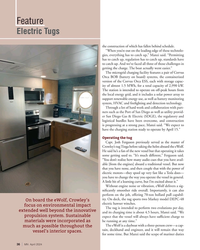 )
April 2024 - Marine News page: 36
)
April 2024 - Marine News page: 36faced all three of those challenges in getting the charge. The boat actually went easier.” The microgrid charging facility features a pair of Corvus Orca BOB (battery on board) systems, the containerized version of the Corvus Orca ESS, each with storage capac- ity of almost 1.5 MWh, for a total capacity
-
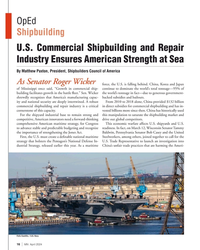 )
April 2024 - Marine News page: 16
)
April 2024 - Marine News page: 16and recognize readiness. In fact, on March 12, Wisconsin Senator Tammy the importance of strengthening the Jones Act. Baldwin, Pennsylvania Senator Bob Casey and the United First, the U.S. must create a de? nable national maritime Steelworkers, among others, joined together to call for the strategy
-
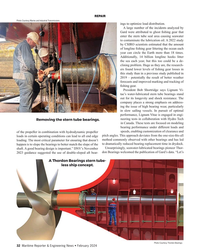 )
February 2024 - Maritime Reporter and Engineering News page: 32
)
February 2024 - Maritime Reporter and Engineering News page: 32in a previous study published in 2019 – potentially the result of better weather forecasts and improved marking and tracking of ? shing gear. President Bob Shortridge says Lignum Vi- tae’s water-lubricated stern tube bearings stand out for its longevity and shock resistance. The company places a strong
-
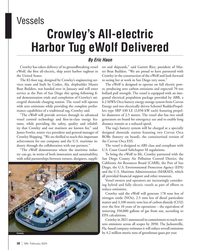 )
February 2024 - Marine News page: 38
)
February 2024 - Marine News page: 38vice president and general manager of designed shoreside station featuring two Corvus Orca Crowley Shipping. “We are thrilled to reach this important BOBs (battery on board), the containerized version of achievement for our company and the U.S. maritime in- the Corvus Orca ESS. dustry through the collaboratio
-
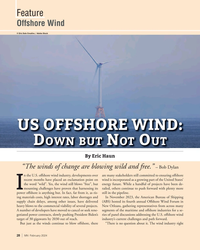 )
February 2024 - Marine News page: 28
)
February 2024 - Marine News page: 28Feature Offshore Wind © Eric Dale Creative / Adobe Stock US OFFSHORE WIND: D N OOWN BUT OT UT By Eric Haun – Bob Dylan “The winds of change are blowing wild and free.” n the U.S. offshore wind industry, developments over are many stakeholders still committed to ensuring offshore recent months have
-
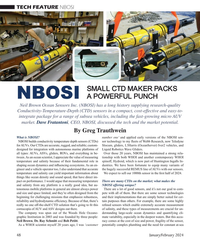 )
January 2024 - Marine Technology Reporter page: 48
)
January 2024 - Marine Technology Reporter page: 48Institution in 2003 and was founded by three people: mate variability, especially in the deepest waters. But this accu- Neil Brown, Dr. Ray Schmitt and Bob Petitt. racy comes at the cost of size and power, fragility of the sensor, As a WHOI scientist myself 20 years ago, I was ‘customer potentially complex
-
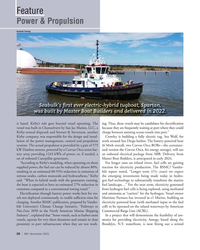 )
November 2023 - Marine News page: 28
)
November 2023 - Marine News page: 28work around San Diego harbor. The battery powered boat systems. The actual propulsion is provided by a pair of 575 (6 Mwh overall, two Corvus Orca BOBs—the container- kW Danfoss motors, powered by a Corvus Orca series bat- ized version the Corvus Orca, for energy storage), will use tery array providing
-
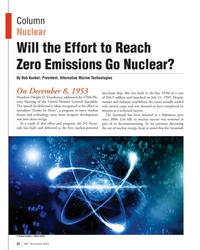 )
November 2023 - Marine News page: 22
)
November 2023 - Marine News page: 22Column Nuclear Will the Effort to Reach Zero Emissions Go Nuclear? By Bob Kunkel, President, Alternative Marine Technologies On December 8, 1953 merchant ship. She was built in the late 1950s at a cost President Dwight D. Eisenhower addressed the 470th Ple- of $46.9 million and launched on July 21
-
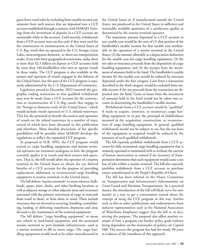 )
November 2023 - Marine News page: 19
)
November 2023 - Marine News page: 19gains from vessel sales by excluding from taxable income any the United States or, if manufactured outside the United amounts from such sources that are deposited into a CCF States, not produced in the United States in suf? cient and account established through a contract with MARAD. Earn- reasonably
-
 )
November 2023 - Marine News page: 18
)
November 2023 - Marine News page: 18Column Legal Beat Bringing the Capital Construction Fund Program Ashore By James Kearns, Special Council, Jones Walker LLP On May 5, 2023, base amount, providing a total of more than $662 million the White House announced that the Environmental Pro- for FY 2023. The NOFOs that have been issued for
-
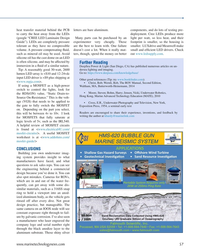 )
September 2023 - Marine Technology Reporter page: 57
)
September 2023 - Marine Technology Reporter page: 57LED array is <$10 and 12-24vdc input LED driver is <$9 plus shipping at Other good references (Tip: try www.book? nder.com):
. • Christ, Bob; Wernli, Bob, The ROV Manual, Second Edition, If using a MOSFET as a high-power Waltham, MA, Butterworth-Heinemann, 2014 switch to control the lights -
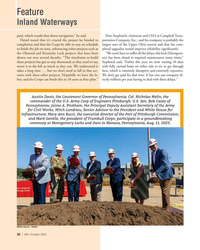 )
October 2023 - Marine News page: 30
)
October 2023 - Marine News page: 30.” Austin Davis, the Lieutenant Governor of Pennsylvania; Col. Nicholas Melin, the commander of the U.S. Army Corp of Engineers Pittsburgh; U.S. Sen. Bob Casey of Pennsylvania; Jaime A. Pinkham, the Principal Deputy Assistant Secretary of the Army for Civil Works; Mitch Landrieu, Senior Advisor to the
-
 )
October 2023 - Marine News page: 11
)
October 2023 - Marine News page: 11themselves, key built winches for jeep tugs and mercy ships especially. both aware of the marine industry and Markey’s reputa- In 1978, Blaine Dempke and Bob LeCoque joined tion for quality. Six months later we had new majority the company, starting out at the bottom. LeCoque was a owners. I continue to
-
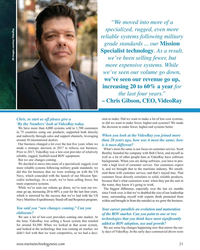 )
July 2023 - Marine Technology Reporter page: 21
)
July 2023 - Marine Technology Reporter page: 21most the same is our focus on customer service. Scott Prior to 2017, VideoRay was a low-cost provider of relatively Bentley founded the company with Bob Christ, and myself as reliable, rugged, football-sized ROV equipment. well as a lot of other people here at VideoRay have software But we saw changes
-
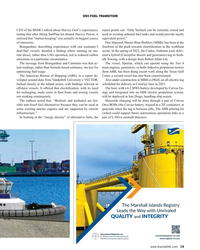 )
April 2023 - Maritime Reporter and Engineering News page: 19
)
April 2023 - Maritime Reporter and Engineering News page: 19and methanol are fea- Shoreside charging will be done through a pair of Corvus sible non-fossil fuel alternatives because they can be used in Orca BOBs (the Corvus battery, housed in a 20’ container), at some existing marine engines and are supported by current quayside when the tug is between jobs
-
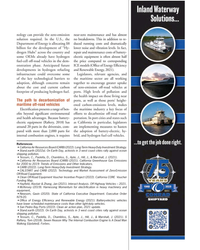 )
April 2023 - Marine News page: 19
)
April 2023 - Marine News page: 19nology can provide the zero-emission near-zero maintenance and has almost solution required. In the U.S., the no breakdowns. This in addition to re- Department of Energy is allocating $8 duced running costs and dramatically billion for the development of “Hy- lower noise and vibration levels. In fact
-
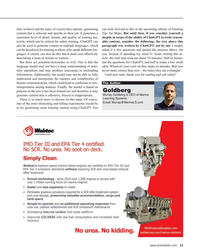 )
February 2023 - Maritime Reporter and Engineering News page: 11
)
February 2023 - Maritime Reporter and Engineering News page: 11for ChatGPT, and half to make a few small language model may not have a deep understanding of mari- edits. Whatever your view on this, make no mistake. Bob was time operations and may produce inaccurate or misleading never more correct than now - the times they are a-changin’. information. Additionally
-
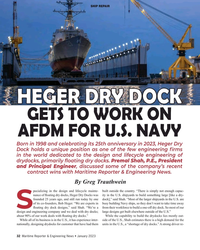 )
January 2023 - Maritime Reporter and Engineering News page: 32
)
January 2023 - Maritime Reporter and Engineering News page: 32large [like a dry- founded 25 years ago, and still run today by one dock],” said Shah. “Most of the larger shipyards in the U.S. are of its co-founders, Bob Heger. “We are experts in busy building Navy ships, so they don’t want to take time away S? oating dry dock designs,” said Shah. “We’re a from their
-
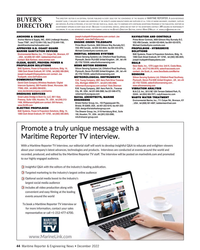 )
December 2022 - Maritime Reporter and Engineering News page: 44
)
December 2022 - Maritime Reporter and Engineering News page: 44SENSING SYSTEMS Environmental Marine, Inc., 711 Colyer Rd., Bronson, KY BAE Systems, Power & Propulsion Solutions, Bldg. 14, , USA , tel:(606) 561-4697, [email protected] Silicon Sensing Systems Ltd, Clittaford Road Southway, 1098 Clark Street Endicott, NY 13760 , tel:(360) 306-2844, contact: Bob Kenison
-
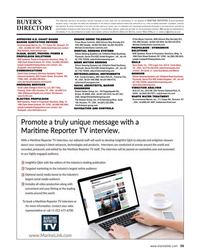 )
November 2022 - Maritime Reporter and Engineering News page: 59
)
November 2022 - Maritime Reporter and Engineering News page: 59.com Environmental Marine, Inc., 711 Colyer Rd., Bronson, KY V5G 4R8 Canada , tel:604 433-4644, fax:604 433-5570, , USA , tel:(606) 561-4697, [email protected] contact: [email protected] PROPULSION - HYBRIDRIVE Bob Kenison, www.envmar.com INERTIAL SENSING SYSTEMS SOLUTIONS
-
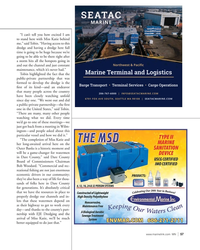 )
November 2022 - Marine News page: 57
)
November 2022 - Marine News page: 57here on the Outer Banks is a historic moment and will be a game-changer for watermen in Dare County,” said Dare County Board of Commissioners Chairman Bob Woodard. “Commercial and rec- reational ? shing are not just enormous economic drivers in our community; they’ve also been a way of life for thou- sands
-
 )
November 2022 - Marine News page: 30
)
November 2022 - Marine News page: 30Column Offshore Wind Fortunes Return to the Sea as the Wind Blows Offshore By Bob Kunkel, Alternative Marine Technologies some of the problems, heralding a world of change with The results of fortunes reduced emissions, government support and the end of fos- and failures are often described as a
-
 )
September 2022 - Marine Technology Reporter page: 74
)
September 2022 - Marine Technology Reporter page: 74, we geTech, Gary Burnhardt, formerly with Benthos, John Kemp, hang out and wait at the prescribed time and place. Allowing WHOI, Frank Snodgrass and Bob Truesdale, formerly from for burn and ascent time, we scan the area around the boat, Scripps, Le Olsen, formerly of UW-APL, and Bart Chadwick, waiting
